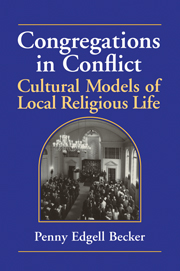Book contents
- Frontmatter
- Contents
- Tables
- Acknowledgments
- 1 “Who We Are” and “How We Do Things Here”: Local Understandings of Mission and Identity
- 2 The Congregations of Oak Park, River Forest, and Forest Park
- 3 Houses of Worship
- 4 Family Congregations
- 5 Community Congregations
- 6 Leader Congregations
- 7 Mixed Congregations
- 8 An Institutional Approach to Local Culture
- 9 American Congregational Religion
- Appendix A Data and Methods
- Appendix B The Interview Questions
- References
- Index
2 - The Congregations of Oak Park, River Forest, and Forest Park
Published online by Cambridge University Press: 07 August 2009
- Frontmatter
- Contents
- Tables
- Acknowledgments
- 1 “Who We Are” and “How We Do Things Here”: Local Understandings of Mission and Identity
- 2 The Congregations of Oak Park, River Forest, and Forest Park
- 3 Houses of Worship
- 4 Family Congregations
- 5 Community Congregations
- 6 Leader Congregations
- 7 Mixed Congregations
- 8 An Institutional Approach to Local Culture
- 9 American Congregational Religion
- Appendix A Data and Methods
- Appendix B The Interview Questions
- References
- Index
Summary
I had been to Oak Park before, to go to a movie or out for ice cream with a friend who had grown up there. Today I was going, for the first time, to do research. I was going to the public library, but I thought I would first drive through to get a feel for the place during the daytime.
Driving to Oak Park from Chicago, the urban feeling stayed with me. There was a lot of traffic for eleven in the morning, and people were speeding on the Eisenhower Expressway. I did not notice much change in the buildings lining the side of the expressway as I approached the exit for Austin Boulevard, on the eastern boundary of Oak Park. And when I exited onto Austin and drove north to the main east–west street, I was passing blocks of brick three-flats and a few city homes crammed together on tiny lots. Most of the people on the sidewalk were African American, but the people in the cars and on the smelly, old city buses were mixed, all ages and races. This is a major city thoroughfare, a commuterway.
When I turned west on the main street, the city feel continued for a while. I did see fewer people on the sidewalks, but there were still large apartment blocks and small houses.
- Type
- Chapter
- Information
- Congregations in ConflictCultural Models of Local Religious Life, pp. 26 - 52Publisher: Cambridge University PressPrint publication year: 1999

